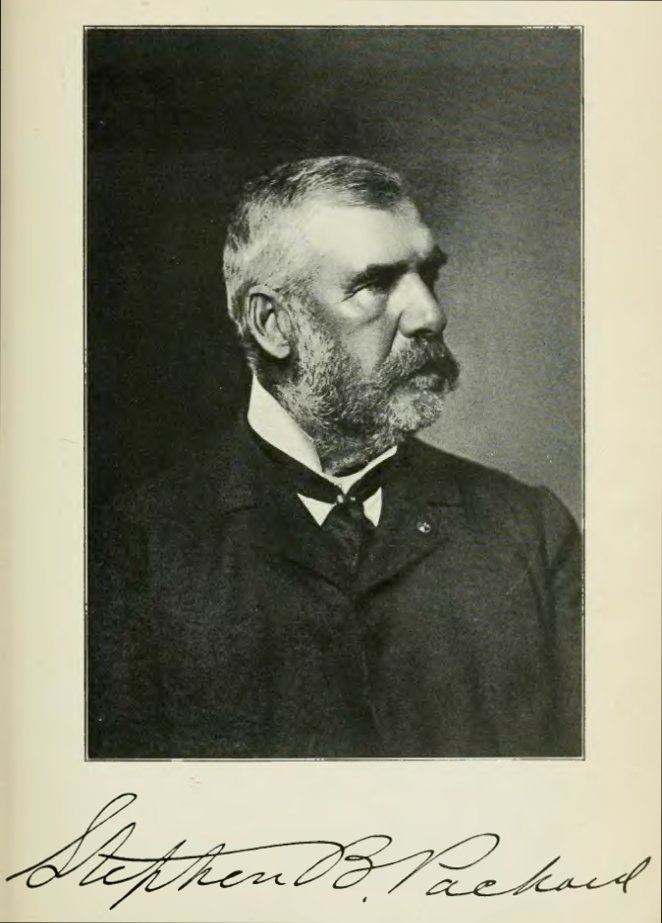Role Politician Died January 31, 1922 | Name Stephen Packard | |
 | ||
Born April 25, 1839Auburn, Maine ( 1839-04-25 ) | ||
Stephen Bennett Packard (April 25, 1839 – January 31, 1922), a native of Maine, emerged as an important Republican politician in Louisiana during the era of Reconstruction. He was the unsuccessful Republican gubernatorial nominee in 1876.
A captain in the Union Army during the American Civil War, Packard was appointed United States marshal in New Orleans in 1871 during the administration of U.S. President Ulysses S. Grant. He emerged as a leader of what was called the "Customhouse Ring", a faction of the Republican Party opposed to Governor Henry Clay Warmoth. By 1872 Warmoth had allied with anti-Grant Republicans and some Democrats, supporting election of Democratic candidate John McEnery.
In 1872, Packard directed the successful gubernatorial campaign of Republican William Pitt Kellogg. Packard supported the impeachment of outgoing Governor Warmoth. A Returning Board appointed by Warmoth certified McEnery as victor, but the Republicans, outraged by election violence and fraud, appointed their own Returning Board. Both parties claimed victory. The legislature impeached Warmoth as governor, on charges of having sold the election. Packard obtained federal recognition of the African American P.B.S. Pinchback as acting governor for the thirty-five days left in Warmoth's term. Kellogg was ultimately recognized by President Grant as the legitimate authority in charge, but violence related to the election resulted in 80-150 deaths of blacks in the Colfax Massacre of 1873, and the paramilitary White League takeover of the state buildings in New Orleans in September 1874, at the cost of nearly 100 casualties among city police and militia. Federal troops restored order for a time, but in January 1875 the Democrats started meeting separately as a legislature at the Odd Fellows Hall.
In 1876 Packard was the Republican candidate for governor. In another disputed election, both Packard and his Democratic opponent, Francis T. Nicholls, held separate inaugurations. Every election since 1868 had had increasing levels of political violence.
The paramilitary White League, effectively an arm of the Democratic Party, had conducted open campaigns of intimidation and physical attacks, to keep freedmen and other Republicans away from the polls. Nicholls had led in the balloting by some 8,000 votes, but the Republican-controlled State Returning Board cited fraud and declared Packard the victor. Pinchback refused to support Packard and endorsed Nicholls. President Grant did not recognize Republicans in Louisiana or South Carolina, which also had disputed elections.
On January 9, 1877, federal troops were withdrawn from New Orleans, as Grant gave up on the state, leaving it to its own devices. The New York Times reported in an article dated February 16, 1877, the headline "The Democratic Assassin. Gov. Packard's Attempted Murder." At that time in New York, Packard was still perceived to be Governor of Louisiana. The article describes the assassin William H. Weldon being wounded in the attempt against Packard.
After the contested election of 1876, the Democratic-backed legislature, allied with Democratic Governor Francis T. Nicholls, selected Henry M. Spofford as United States Senator (this was before the popular election of senators). The Republican-dominated legislature, allied with Republican Governor Packard, had separately selected William Pitt Kellogg as senator. The United States Senate, then dominated by the so-called Radical faction of the Republican party, refused to seat Spofford.
In the Compromise of 1877, the incoming Republican President Rutherford B. Hayes recognized Nicholls as the legitimate Louisiana governor. In exchange, the Louisiana electoral votes were cast for the Hayes-William Wheeler ticket. Similarly, Hayes had recognized the "Redeemer" Democrat, Wade Hampton, III, a Confederate general, as governor of South Carolina, rather than the incumbent Republican Daniel H. Chamberlain. As a result of the national compromise, the US government removed remaining federal troops from Louisiana and South Carolina, despite the patterns of violence and assassinations related to elections.
Packard was appointed as United States consul at Liverpool, as "compensation for surrendering his claim to the governorship." When he returned to the United States in 1885, Packard purchased 1,100 acres of land near Marshalltown, Iowa. He developed it for livestock breeding and worked at that for the next twenty-five years, being recognized for his success in that field.
After more years of election violence, in the late 19th century, the Democrat-dominated Louisiana legislature passed Jim Crow laws and ultimately a new constitution, which effectively disfranchised blacks in the state, a situation that was maintained into the 1960s, excluding blacks from the political process, juries, and local offices. It was a one-party state controlled by Democrats. Packard's was the last strong Republican campaign for governor of Louisiana until 1964.
That year Charlton H. Lyons, Sr., a former Democrat, launched a campaign to rejuvenate the long-moribund GOP in Louisiana, in part in reaction to federal civil rights legislation passed that year by the national Democratic Party. In 1965, Congress passed the Voting Rights Act of 1965, authorizing the federal government to enforce constitutional rights to vote, and blacks began to register and vote in high numbers throughout the South, often allying with the Democratic Party.
Stephen B. Packard is interred beside the remains of his son, Stephen B. Packard, Jr., at the Washelli Columbarium at Evergreen Washelli Memorial Park in Seattle, Washington.
